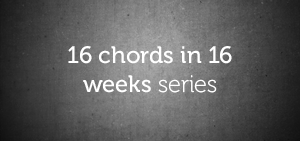You arrived at this page because you are interested in learning about the uses of passing chords.
The use of passing chords is common in jazz and gospel music where the harmony is dynamic.
Although passing chords are used in so many ways, we’ll be focusing on two uses of passing chords in this lesson. But before we get started, let’s refresh our minds on what passing chords are.
A Short Note On Passing Chords
A passing chord is usually a chromatic chord that precedes a scale-degree chord.
The term chromatic means colorful and is used in this case to describe a chord that is foreign to any given key. In the key of C major:
…a typical 6-2 chord progression entails a chord progression from the A minor seventh chord:
…to the D minor seventh chord:
However, if the D minor seventh chord (which is a scale-degree chord):
…is preceded by the A dominant seventh [flat ninth] chord:
The A dominant seventh [flat ninth] chord (which is a chromatic chord):
…is functioning as a passing chord to the D minor seventh chord:
In a nutshell, passing chords are chords that are foreign to the prevalent key that are played or heard before scale-degree chords.
Passing Chords Are Used To Imply A Modulation
Passing chords are used in harmony to establish or contradict a key and sometimes, to imply a modulation.
For example, in the key of C major:
…the use of passing chords can contradict the key. An example of such passing chords is the C dominant seventh chord:
A chord progression from the C dominant seventh chord:
…to chord four (the F major ninth chord):
…contradicts the key of C major:
…and implies a modulation to the key of F:
The chord progression from the C dominant seventh chord:
…to the F major ninth chord:
…implies a 5-1 chord progression in the key of F major:
So, passing chords are used to imply a modulation.
Passing Chords Are Used To Add Tension And/Or Increase Activity
Jazz and gospel musicians use passing chords to add tension and/or increase activity in a chord progression.
For example, in a chord progression from the C major seventh chord:
…to the G major triad:
…we can add tension to the progression by the introduction of passing chords. The D dominant ninth chord:
…can be played before the G major triad:
…and this adds tension to the chord progression.
“Check It Out…”
The C major seventh chord:
The D dominant ninth chord:
The G major triad:
When the chords are played/heard in a progression, the tension of the D dominant ninth can be felt and its resolution into the G major triad.
“In The Same Vein…”
The E dominant seventh [flat ninth] chord:
…and the A dominant seventh [flat ninth] chord:
…can be played before the D dominant ninth chord:
“Check It Out…”
The C major seventh chord:
The E dominant seventh [flat ninth] chord:
The A dominant seventh [flat ninth] chord:
The D dominant ninth chord:
The G major triad:
In the progression above, the origin of the progression is the C major seventh:
…while the destination of the progression is the G major triad:
All the passing chords coming in-between:
The E dominant seventh [flat ninth] chord
The A dominant seventh [flat ninth] chord
The D dominant ninth chord
…are added to add/increase activity in the chord progression.
Final Words
I’m doubly sure you’ve seen two top reasons why passing chords are indispensable in harmony, especially in gospel and jazz harmony.
In a subsequent lesson, we’ll be exploring other uses of passing chords and most especially, how they are applied.
See you then!
Chuku Onyemachi
Latest posts by Chuku Onyemachi (see all)
- The Formation Of Diminished Seventh Chords Used To Be Challenging Until I Did This
- How To Form Seventh Chords In Two Shakes Of A Dog’s Tail Using Third Intervals And The Circle Of Fifths Chart
- I Played The 13sus4 Chord And This Happened…
- How To Build Seventh Chords Like An Architect Using “Foundation And Structure” Concept
- This 4-Week Plan Will Help You Master All The Major Scales







Comments on this entry are closed.